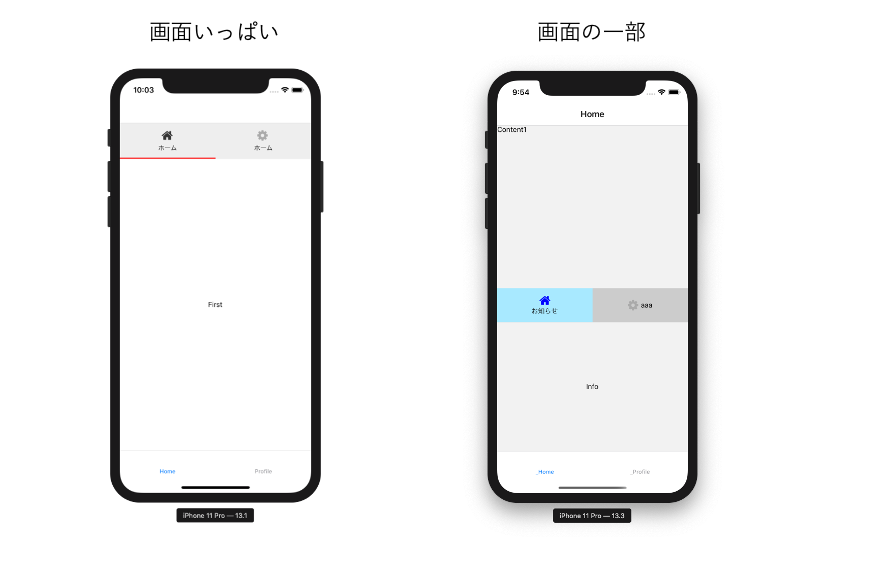やりたいこと
react-navigatorで普通にネストすると画面いっぱいになります(そうしないやり方もありますが、めんどくさい)。今回やりたいのは画面の一部としてTabコンテンツを利用したい(かつなるべく簡単に)。
react-navigationのtab-navigationを使うより、そのベースになっているreact-native-tab-viewを使う方が簡単らしいので試してみました。
準備
私はexpoを使ってるのですが、2020年1月6日現在、いろいろ依存関係の問題などがあるのでモジュールのインストールはやや複雑?です。
場所の確保
まず場所の確保。言語とかはお好みで。
expo init innerTab
cd innerTab
必要モジュールのインストール
navigationの必須モジュール
まず、react-navigationと必須なモジュール。react-navigationのページにある通りにインストールします。
expo install react-navigation react-native-gesture-handler react-native-reanimated react-native-screens
各種ナビゲーション
次に必要なnavigationをインストール。
expo install npm react-navigation-stack react-navigation-tabs
エラー対応
下記2つのモジュールが無い!とエラーがでるのでインストール。
expo install react-native-safe-area-context @react-native-community/masked-view
内部Tab用モジュールインストール
内部Tabを作成するためのモジュールをインストール。アイコン表示も試したいので追加。
expo install react-native-tab-view react-native-vector-icons
実装
で、実装。まずApp.jsでレイアウトを行います。
全体を包むTab(HomeTab)を作って、そのうちのHome.jsに子Tabを記述します。
なお、私の趣味でStackNavigationでラップしています(必須ではありません)。
import React from 'react';
import { StyleSheet, Text, View } from 'react-native';
import { createAppContainer } from 'react-navigation';
import { createStackNavigator } from 'react-navigation-stack';
import { createBottomTabNavigator } from 'react-navigation-tabs';
//import screens
import Home from './screens/Home';
import Profile from './screens/Profile';
import Info from './screens/Info';
import News from './screens/News';
//HomeStack
const HomeStack = createStackNavigator(
{
Home: {
screen: Home,
}
}
);
const ProfileStack = createStackNavigator(
{
Profile: {
screen: Profile,
}
}
);
//HomeTab
const HomeTab = createBottomTabNavigator(
{
_Home: {
screen: HomeStack,
},
_Profile: {
screen: ProfileStack
}
}
);
//AppContainer
const AppContainer = createAppContainer(HomeTab);
class App extends React.Component {
render() {
return (
<AppContainer />
);
}
}
export default App;
いよいろ本丸の子Tab。普通は分けてもいいのでしょうけど、Home.jsに全部書いちゃいます。
import React from 'react';
import { StyleSheet, Text, View } from 'react-native';
import { TabView, TabBar, SceneMap } from 'react-native-tab-view';
import Icon from 'react-native-vector-icons/FontAwesome';
import Info from './Info';
import News from './News';
class Home extends React.Component {
state = {
tabIndex: 0,
tabRoutes: [
//普通にアイコン表示
{ key: 'info', title: 'お知らせ', renderIcon: (color) => (<Icon size={24} name="home" color={color} />) },
//titleと横並び(titleは消す)
{ key: 'news', renderIcon: (color) => (<View style={{ flexDirection: "row", alignItems: 'center' }}><Icon size={24} name="cog" color={color} /><Text style={{ marginLeft: 5 }}>aaa</Text></View>) }
],
}
render() {
return (
<View style={{ flex: 1 }} >
<View style={{ flex: 1 }}>
<Text>Content1</Text>
</View>
<TabView
style={{ flex: 1 }}
navigationState={{
index: this.state.tabIndex,
routes: this.state.tabRoutes,
}}
renderScene={SceneMap({
info: Info,
news: News,
})}
onIndexChange={(index) => this.setState({ tabIndex: index })}
renderTabBar={(props) => (
<TabBar
{...props}
style={{ backgroundColor: "#ccc" }}
labelStyle={{ color: "#000" }}
indicatorStyle={{ backgroundColor: "#A8E9FF", height: "100%" }} //heightを100%にすれば背景色となる・・・
renderIcon={({ route, color }) => route.renderIcon(color)}
activeColor={"#00f"}
inactiveColor={"#aaa"}
/>
)}
/>
</ View>
);
}
}
export default Home;
その他のページはただページ名を中央に表示しているだけ。Info, Profile, Newsなど。。。
書きを参考にscreensフォルダの中に着くるとよいでしょう。
import React from 'react';
import { StyleSheet, Text, View } from 'react-native';
class Info extends React.Component {
render() {
return (
<View style={{ flex: 1, justifyContent: 'center', alignItems: 'center' }}>
<Text>Info</Text>
</View>
);
}
}
export default Info;
以上です。
